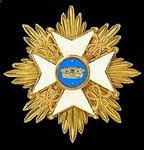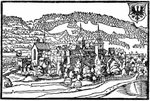Chef from 3rd November 1741 until 12th December 1788: Major General Heinrich, Margrave of Brandenburg-Schwedt (he had lost the favour of Frederick so although he drew the salary of his rank he did not actually command the regiment and the regiment accordingly was the only one in the army not to have a guard company).
Commanders in the SYW: to the 22nd April 1760 Colonel Balthasar Rudolf von Schenkendorff, later Major General; from then to 2nd April 1764 Major Heinrich Wilhelm von Lettow, who transferred to IR46.
The flags are unusual in not following the usual pattern; neither has a white centre.
First raised from a variety of odd sources in 1741.
The regiment was with Field Marshal Schwerin's Corps in 1756 and saw no action. In January 1757 it was strengthened by 300 men. Schwerin went to meet Frederick at Prague and in the battle on 6th May the regiment was in the second line on the left wing fighting "without particular distinction". The grenadiers (joined with those of IR33) took the Isar bridges at Zamost and were destroyed at Kolin on 18th June; only one officer, four NCOs and 19 men were uninjured, and 39 wounded were saved from capture. The battalion was filled up with Saxon prisoners. While marching back under the command of Prince August Wilhelm the Second Battalion was captured in the ruins of Zittau.
In 1758 IR42 was part of the King's army, after the prisoners had returned via Jägerndorf in mid-April. As part of Keith's Corps it was part of the encirclement of Olmütz from the west from 20th May to July 1st, and then the King withdrew as the military situation worsened. From August it was back in Silesia, this time under Margrave Karl.
In 1759 it was under the command of Major General von Wobersnow as part of the mission to destroy the Russian magazine at Posen and then fought at Konradswalde in the County of Glatz. July to August it was in camp at Schmottseiffen, under Prince Heinrich from July 29th.
In 1760 the First Battalion was with Fouqé at Landeshut and the survivors of that fight captured. The Second Battalion was with Zieten at Freiburg. The grenadiers were at Dresden, Liegnitz (Duffy Army of Frederick the Great 1st Edition shows about 25% casualties), Hochgiersdorf and Torgau. Their commander was awarded the Pour-le-merite and promoted to colonel.
In Goltz's Corp in 1761, the Second Battalion served in the Pomeranian Campaign.
In August 1762 under Bevern what was left of the regiment took part in an action that beat four Austrian corps north of Peilau. The Second Battalion fought to the last man on the left wing. The King arrived in time to see off the enemy.
Christopher Duffy in AFG 1/2 says: "A very ordinary regiment."
And this was the uniform of a fusilier in 1756:
Here's another for the Prussophiles, which also happens to be the first of the Prague Prussian Flags Project; yes, I know I still have the flags of IR 15 to do to complete the flags of Rossbach and Leuthen! I have also recently discovered a contenporary source that shows many more flags of the Austrian army under Charles VI in the later part of his reign so there will be more 1740s Austrian infantry flags (and possibly cavalry ones too) to follow...




















